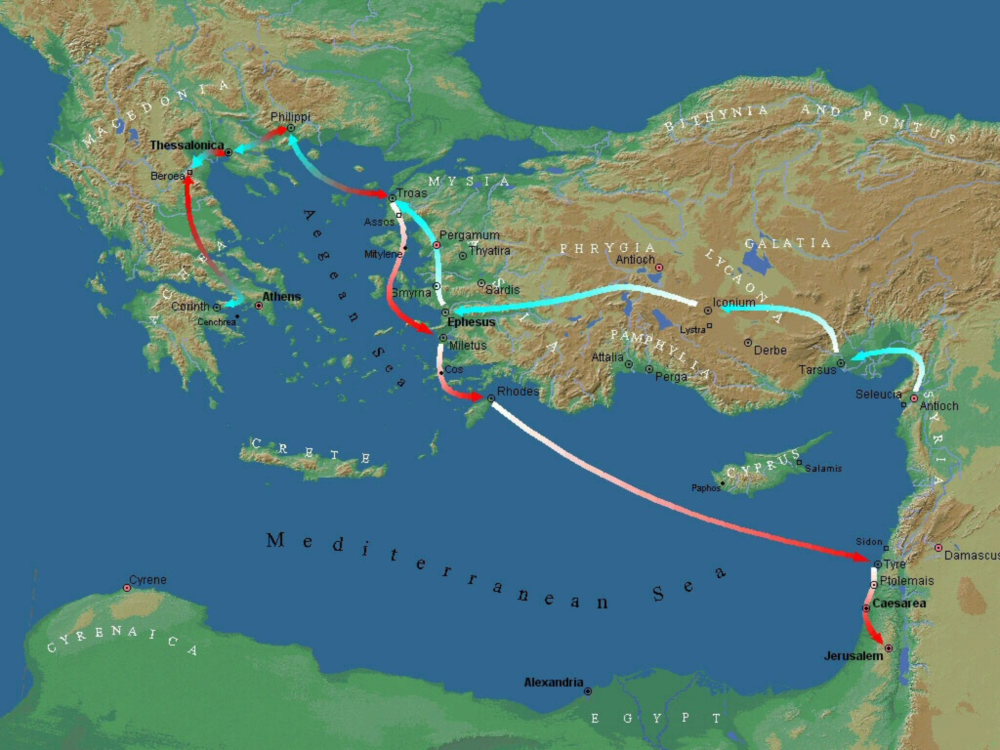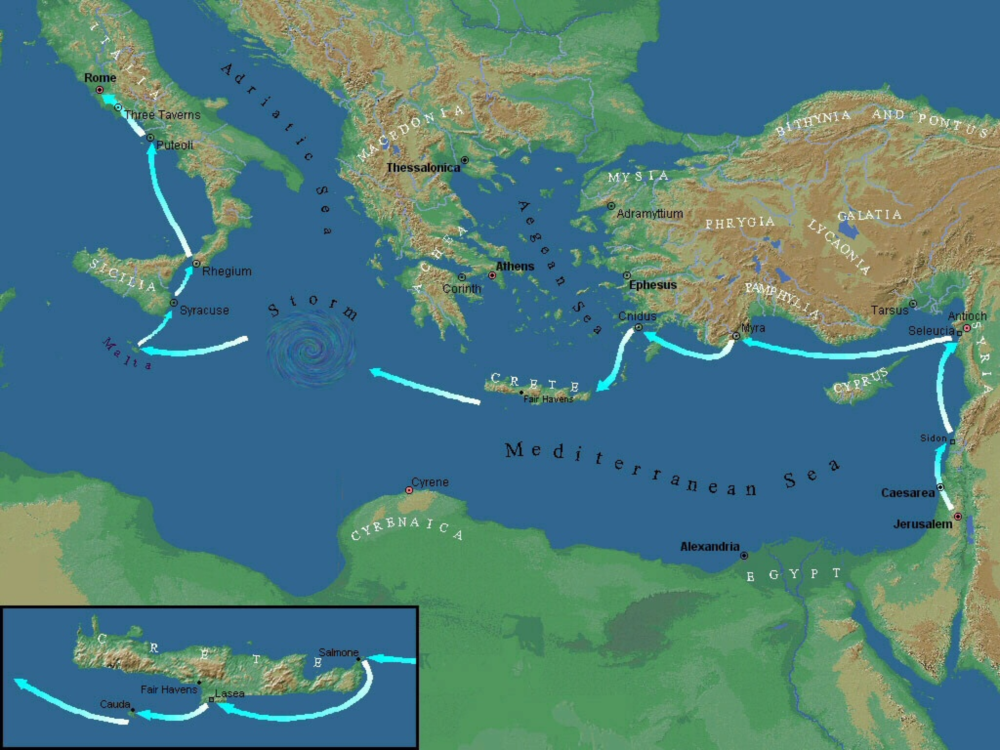During the years of AD 52-57, Paul travels extensively through Asia Minor and modern-day Greece. After five years of evangelism, his third missionary journey ends with him returning to Jerusalem (see the map just below). Paul’s Christian brothers warn him not to go back to Jerusalem, as they fear he will be imprisoned, but Paul insists on returning.

Shortly after his arrival in Jerusalem, Paul is arrested in AD 57. Not satisfied with his incarceration, some forty Jews, with the approval of the Sanhedrin, plot to kill Paul. The Roman authorities, however, are tipped off by Paul’s nephew and Paul is removed to the city of Caesarea. Here he appears before Governor Felix. Felix interrogates Paul and finds him to be innocent. Zondervan’s [amazon_textlink asin=’031095097X’ text=’NIV, The Story‘ template=’ProductLink’ store=’toughquest_plugin-20′ marketplace=’US’ link_id=’32290c63-8cf0-11e7-9932-ed98c12bfb71′], describes the following two years in Caesarea:
Paul’s arrest resulted from anything but criminal behavior, and the years he spent waiting for Roman justice would have broken most people. None of the officials he faced could find legal fault with him (the charge was sedition), yet no one would release him for fear of political repercussions. The Roman governor Felix held Paul in custody at Caesarea for two years, sending for him frequently in hope that Paul would offer him a bribe. Finally, Felix was recalled to Rome for failing, among other things, to control local insurrection.
The Jewish leaders immediately asked the new governor, Festus, to transfer Paul from Caesarea to Jerusalem. Paul, a Roman citizen, was forced to exercise his right of appeal to Caesar in order to avoid the grave danger of going to Jerusalem. Next, Paul appeared before King Herod Agrippa II. Agrippa and Festus agreed that Paul wasn’t guilty of any crime. But Paul had made an appeal to Caesar, so the Roman Imperial Court would finally get the privilege of disposing of his case.
Acts 27 picks up the narrative in AD 59 with Paul finally leaving for Rome. Accompanying Paul to Rome are Luke and a Christian brother named Aristarchus. Chapter 27 will give a detailed account of Paul’s harrowing sea adventure which eventually leads to a shipwreck. Luke’s lively and suspenseful account of the journey is meant to demonstrate the reality of God’s control over all circumstances.
In Acts 23:11, Jesus had spoken to Paul, saying, “Take courage, for as you have testified to the facts about me in Jerusalem, so you must testify also in Rome.” Luke wants to show that despite numerous obstacles, God will keep His promise to Paul. Paul would someday testify about Jesus in Rome.
Paul’s journey to Rome is mapped below. Verses 1-5 describe Paul’s travel from Caesarea to Sidon to Seleucia to Myra. This first leg of the trip likely lasts about two weeks. Once in Myra, Julius, the Roman centurion in charge of Paul and the other prisoners, transfers everyone to a different vessel. The new ship is a grain transport that travels between Egypt and Rome. Egypt was an important supplier of grain to Rome.

The ship heads west toward Cnidus and the island of Crete. On the south side of Crete, at a place called Fair Havens, the boat anchors. The owner of the vessel, the captain, and Julius must now make a difficult decision. Should they stay at Fair Havens during the next several months, or should they seek shelter in a safer port that will better protect them from the winds and sea during the winter months?
Paul argues that they should stay in Fair Havens because it is too dangerous to continue westward. Clinton Arnold, in [amazon_textlink asin=’0310613191′ text=’John, Acts: Volume Two (Zondervan Illustrated Bible Backgrounds Commentary)‘ template=’ProductLink’ store=’toughquest_plugin-20′ marketplace=’US’ link_id=’639b9660-8cf0-11e7-9d23-5d583bc8e1b3′], writes,
According to ancient sources, sea travel was particularly risky in the fall from September 14 to November 11 and considered extremely dangerous from November 11 to March 10. Visibility (mists and fogs) as well as the constant threat of severe winter storms rendered this period an inadvisable time to travel by sea.
Since Luke mentions the Fast (Day of Atonement) having already occurred, but not the Feast of Tabernacles, it is likely that they arrived in Fair Havens between October 10-15, AD 59. Thus, they were well into the time of year where sea voyages across the Mediterranean were quite dangerous.
Julius heeds the advice of the majority, who decide to coast along the southern coastline of Crete for fifty miles to find a better port (Phoenix) to spend the winter. This voyage should have typically only taken about a day.
Verses 13-44 vividly describe the disaster that befalls the ship of 276 passengers. Within hours of leaving Fair Havens, a violent storm with close to hurricane force winds takes control of the boat, leaving the captain and crew powerless to control its direction. The storm would last approximately two weeks, blowing the ship west across the Mediterranean (see map above).
With no knowledge of where they are, for they cannot see the sun, moon, or stars, and no way to control their direction, the crew takes steps to keep the ship afloat. First, they pull up the lifeboat to keep it from flooding. Second, they fasten ropes around the bow to provide additional support for the frame of the ship. Third, they lower all the sails but one. Fourth, they throw some of the cargo and equipment overboard. John Polhill, in [amazon_textlink asin=’0805401261′ text=’vol. 26, Acts, The New American Commentary‘ template=’ProductLink’ store=’toughquest_plugin-20′ marketplace=’US’ link_id=’84ba223f-8cf0-11e7-b1a1-416338dc9951′], provides some background:
There was really little that an ancient ship could do to fight a violent storm. They surely had the mainsail down and allowed the vessel to be borne along at the whim of the storm. By this time the ship may have developed leaks, and it seemed wise to lighten its load. The excess cargo was jettisoned. Luke did not specify what was thrown from the ship. It may well have been some of the load of grain, though it later became clear that not all of that was jettisoned at this time (cf. v. 38). Still the ship was so threatened that it was necessary on the next day, the third day of the storm, to throw even more overboard. Again it is not clear what was ejected. Luke referred to it as the ship’s ‘equipment’ (skeuēn, v. 19). Smith suggested that it was the ship’s mainyard, the long spar used to support the mainsail. This would explain his reference to the sailors doing this ‘with their own hands.’ There would be no equipment sufficient for jettisoning such a huge beam. It would have taken the combined manual effort of the crew.
After several days, when all hope of survival is lost, Paul receives a message from an angel of God which he relays to everyone on the boat. The angel assures Paul that every person on the ship will be saved, but that the ship itself will be lost.
After two weeks, the ship’s crew suspects they are nearing land, probably because they can hear the surf breaking on rocks. They decide to measure how deep the water is to see how close they are to land. Arnold describes the process:
It must be remembered that there were no sonar or acoustical instruments available to ancient sailors. The ‘sounding’ referred to here was a depth measurement taken by a hand line. A series of lead weights were attached to the end of the line separated by measured intervals. Archaeologists have discovered some of these weights. The bottom of the weight was hollowed out so that it could be filled with tallow or grease. When lowered and drug on the floor of the sea, the grease would pick up rocks and debris.”
They measure 120 feet and then 90 feet before deciding to drop four anchors into the water at the stern of the ship to stop the boat’s forward movement and to keep the bow pointed in the direction of land. That same evening, some of the sailors try to escape the ship in the lifeboat, but Paul makes sure that the Roman soldiers stop them.
Just before dawn, Paul encourages everyone on the vessel to eat so that they will have the strength to swim ashore. Paul reminds them that everyone on the boat will be saved and he gives thanks to God. Once the ship’s passengers and crew eat, the rest of the grain is thrown overboard to lighten the load.
As morning dawns, they cast off the anchors and set sail toward a beach within eyesight. Unfortunately, as they sail toward the beach, the ship strikes an unseen shoal and comes to rest. Everyone on board must evacuate because the waves are crashing against the stern of the ship and breaking it apart. The Roman soldiers plan to kill all the prisoners, lest they escape, but Julius, the centurion, stops them because he does not wish to see Paul die.
Those who can swim jump overboard and swim to shore. Those who cannot are instructed to use wooden planks from the ship as flotation. The plan works, and every single person on the ship makes it safely to shore. God’s promise that nobody on the ship would be harmed in the shipwreck has been fulfilled!